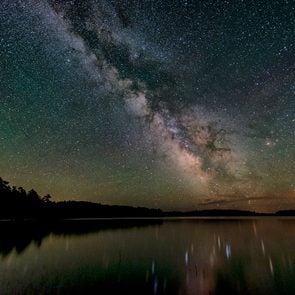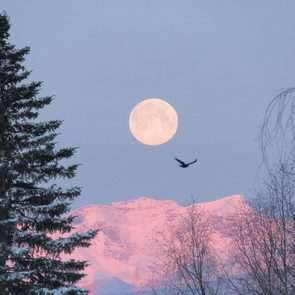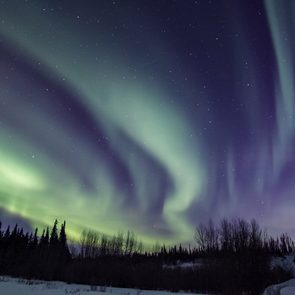These Night Skywatchers Chase the Northern Lights Across Canada
A shared passion for nature's greatest light show has drawn this close-knit community together.
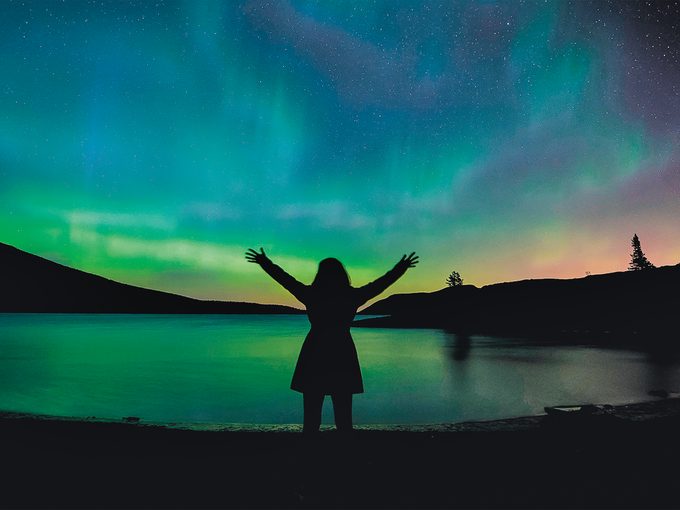
Chasing the Northern Lights in Canada
For an ever-growing community of northern-latitude-based night skywatchers in Alberta and across Canada, a trifecta of clear skies, active solar activity and a southern tip to our magnetosphere can only mean that when it comes to seeing the northern lights—it’s game on!
Alberta Aurora Chasers (or AAC), a social media-based group, began as a small group of night sky enthusiasts, and has swelled considerably. These members have one common goal—to see the aurora borealis. Chris Ratzlaff, Alberta Aurora Chaser’s group administrator, reflected recently on the explosive popularity of chasing the northern lights in Canada, and the phenomenal STEVE (sub auroral arcs). “The Alberta Aurora Chaser community started as a small group of experienced aurora hunters in 2012, helping one another improve our ability to see the aurora within Alberta, an area at a latitude with only sporadic aurora activity… In 2015, our community started to focus on helping others in Alberta learn how to determine when they might be able to catch the sporadic auroral displays that grace our skies. Ever since then, our community has been increasing by at least 50 percent per year, to over 26,000 members currently, with members across Canada and around the world (though, we’re still largely Albertan in composition).”
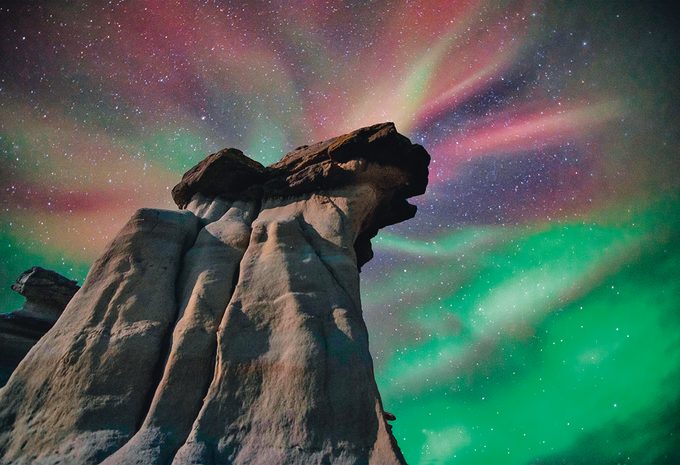
Attracting NASA’s Attention
An exciting partnering of citizen science and scientists from the University of Calgary and NASA have drawn significant international attention to the beautiful arc STEVE that can appear with a northern light show. A recent Canadian documentary, Chasing Steve, profiles several of these Alberta-based chasers and how, through photographs and discussion, they managed to get the attention of the scientific community internationally, including NASA. A program called Aurorasaurus has been developed through NASA Goddard scientist Liz MacDonald’s efforts, allowing ordinary Canadians on the ground to report their aurora sightings, furthering research in the process. This truly unique collaboration between citizens and the worldwide scientific community has demonstrated how a love of nature and exploring our province at night can bring about and drive new discoveries in science! In 2019, several aurora-chasing Albertans were recipients of a very special award from NASA for bringing attention to STEVE (Strong Thermal Emission Velocity Enhancement).
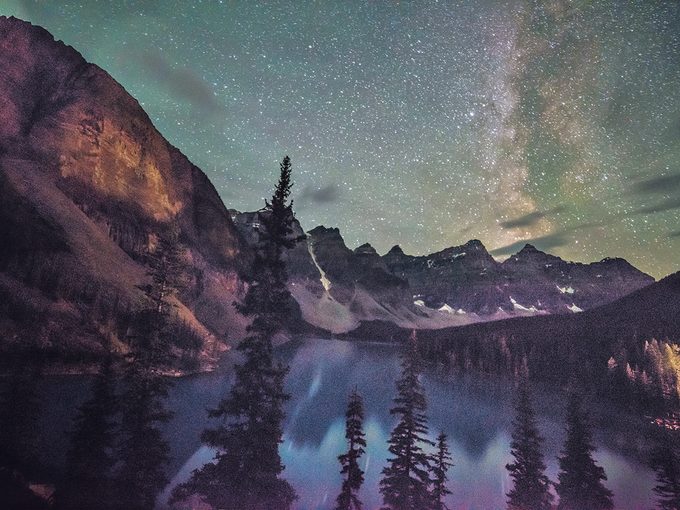
Anything Can Happen
A nightly thread of chatter on social media is started in AAC when solar conditions look favourable, and the excitement among the many members is palpable. Everyone wants to know the best place to go, what kind of camera to take, and when it is poised to “happen.” People are excited to take their children, family members and out-of-town visitors to the best spots in the hope of catching a celestial show. Dozens of members weigh in, posting photos, comparing sightings, and sharing the thrill when the beautiful pillars of light begin to dance in Canada’s northern skies. Since the aurora rotates around Earth from the northeast, comments pour in from across the country, informed skywatchers reporting bands of light in northern Manitoba and Saskatchewan, alerting the Albertans and British Columbia night sky enthusiasts that a show is imminent. It’s important to note: this is nature and not a scheduled movie—anything can happen anytime, and there is never a guarantee even when conditions are all aligned!
Explore more awe-inspiring natural wonders of Canada.
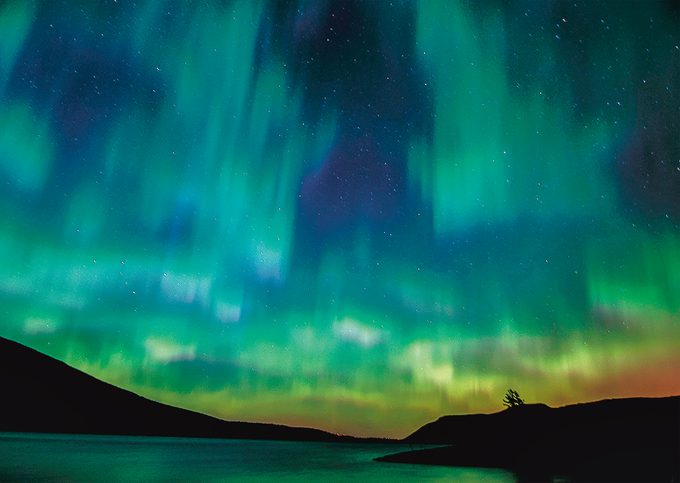
Everyone is Welcome
Members span from the northern areas of Atlantic Canada all the way to northern B.C., everyone in their little corner of the country hoping to see the magical display. Take a drive north of Calgary on such an active evening, and you will inevitably spot random vehicles pulled over, small groups of photographers with tripods out at some favourite spots. There are even recommendations of best viewing locales in the group itself, and members are always hospitable to those totally new to the northern lights experience. You don’t need a fancy camera or a scientific background to participate or learn—it’s simply a matter of following the discussions, jumping in the car and heading to dark skies away from the city lights. Of course, aurora chasing is far less “chase” and more waiting, so patience is essential. For some, having a whole host of gear to photograph these lights is the ultimate goal, including a tripod, remote shutter and a wide lens with a low F-stop. But Albertans also constantly post photos taken with cell phones or point-and-shoot cameras; it is a show of nature open to anyone at any skill or interest level. There is a certain bond felt among people watching this display at night, knowing that all over Canada, others are sharing the same magical nighttime experience.
Check out more northern lights pictures that’ll take your breath away.
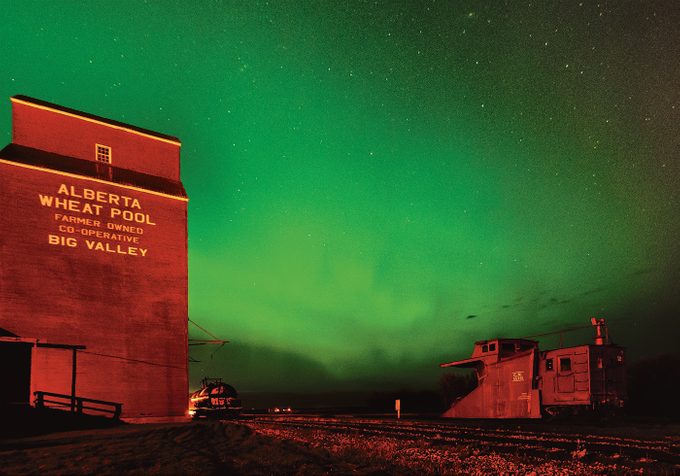
Helpful Hints
On one of my more legendary aurora gatherings on New Year’s Eve, friends visiting from France showed up with mulled cider and fois gras, sitting in lawn chairs and standing in awe, frigidly admiring the beautiful green and purple bands dance and undulate across the Prairie skies. Thanks to all of today’s apps and technology, it is possible to know minute by minute when activity might be expected, even with only a very basic understanding of the science behind the aurora borealis. It is essential to dress for chillier conditions even in summer, as hands and camera gear can get cold quickly. In summer, blankets, and even a coffee or hot chocolate, give the celestial show a sense of occasion, Canadian-style!
Don’t miss this gorgeous gallery of prairie grain elevators.
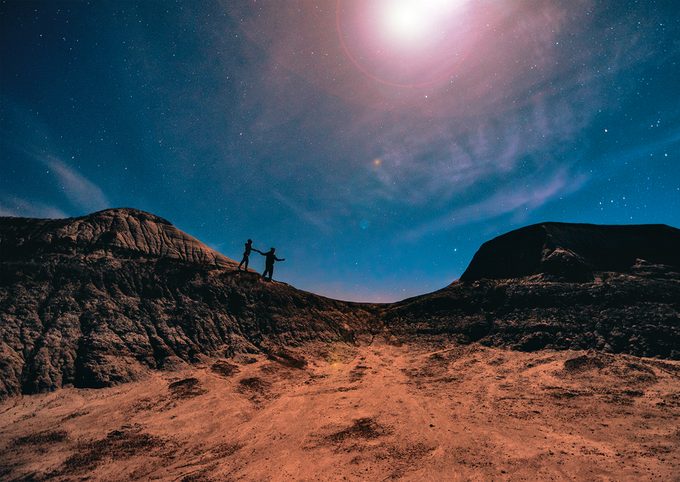
A Strong and Supportive Community
There is a wonderful by-product of witnessing these dancing pillars in a sky full of stars and that is the gift of perspective. The night sky has a healing way of putting all of the world’s turmoil and problems in perspective, as you stand under a billion stars and listen to the peaceful sounds of the night. Through this shared passion, it has also created a very strong and supportive community of nature-loving astro fans. It’s not unheard of to read of someone stuck in a snowbank or have a flat tire on a country road, only to have four or five other night skywatchers in the area show up to good-heartedly pull them out or offer assistance. If the aurora doesn’t come out to play, the photos are instead that of space station fly-bys, meteors caught on camera or Milky Way and starscapes.
The night skies have truly drawn Canadians together. A huge pool of beautiful photos, videos and friendships have been created in this vibrant community. Other groups in Saskatchewan, Manitoba and Ontario as well as Atlantic Canada, and as far as the United States and Tanzania have allowed Canadians to collaborate and share their learning, questions and experiences with a huge group of nature-lovers and photographers internationally. The best part is, when it comes to the northern lights in Canada, it is never the same show twice!
Inspired to seek out the northern lights in Canada? Find out the best places to catch the aurora borealis across the country.
